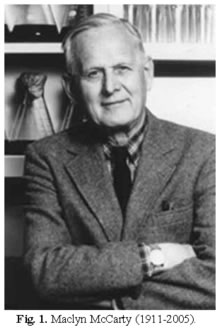Mi SciELO
Servicios Personalizados
Revista
Articulo
Indicadores
-
 Citado por SciELO
Citado por SciELO -
 Accesos
Accesos
Links relacionados
-
 Citado por Google
Citado por Google -
 Similares en
SciELO
Similares en
SciELO -
 Similares en Google
Similares en Google
Compartir
International Microbiology
versión impresa ISSN 1139-6709
INT. MICROBIOL. vol.8 no.1 mar. 2005
| OBLITUARIES | ||
|
| ||
| Maclyn McCarty (1911-2005) | |
"If I have seen further, it is by standing on the shoulders of giants" (letter of Isaac Newton to Robert Hooke). This well-known sentence of Newton finds its correct meaning in biology through the work of Oswald Avery (1877-1955), Colin MacLeod (1909-1972), and Maclyn McCarty (1911-2005) that was published in 1944 in The Journal of Experimental Medicine, which showed that DNA carried genetic information. These giants of molecular biology attained scientific evidence to provide shoulders strong enough to allow Crick and Watson to build on the foundations laid down by this group to postulate, 9 years later, the double-helix model of DNA. Maclyn McCarty (Fig. 1) died in New York on January 3, 2005, at age 93. At the time of his death, he was an active editor of the above-mentioned journal, which is published by The Rockefeller University.
In the 1930s, Streptococcus pneumoniae (pneumococcus, the causal agent of pneumonia) was a dangerous human killer and the leading cause of death. Indeed, it was referred to as the "the knight of death" since mortality due to pneumococcus infection was higher than that due to heart diseases and cancer together. In those days, Oswald Avery was deeply concerned about pneumonia. He was aware that the capsular polysaccharide enveloping S. pneumoniae, giving the bacterium its characteristic smooth appearance, was its major virulence factor. He was also aware, from the notable experiments carried out by the British physician Frederick Griffith, in 1928, that the simultaneous inoculation of mice with a mixture of live avirulent bacteria (rough phenotype) and dead smooth virulent strains resulted in the isolation from dead mice of only the smooth phenotype. The substance responsible for this unexpected phenotypic change was called "the transforming principle". Avery and his team took advantage of the natural transformation displayed by pneumococcus, i.e., the bacterium's capacity to incorporate some component from crude extracts of the smooth variant into the rough strain, to recreate and extend in vitro Griffith's observations. These types of experiments restored, in noncapsulated strains, the "sugar-coated bacteria", as Avery liked to say to McCarty. The pace of the work of Avery's lab was speeded up when the young McCarty joined his laboratory. His special skill as a biochemist in preparing highly purified DNA by using several pivotal enzymes, including DNase and RNase, was fundamental to the conclusion that genes were made exclusively of DNA. In other words, that DNA was the "transforming principle".
The contribution of Avery, MacLeod, and McCarty to the development of molecular biology subsequently became well-known but was only very slowly accepted by the scientists of the time, on whom the Nobel Prize officials most relied. Some scientists explain this discrepancy by the fact that the "three wise men" were "too modest" and that they paid too little attention to those social events mandatory (even more so today!) for promoting scientific achievements. It has also been said that The Journal of Experimental Medicine was a rather "obscure journal" in which to have published such important results. In remarkable contrast to such self-indulgent explanations, credit should be given to a recent editorial in Nature: "And the fact that Avery, MacLeod and McCarty were not awarded the Nobel Prize is an oversight that, to this day, still puzzles." (Nature, 2003, 421:406). This must be shouted from the rooftops!















